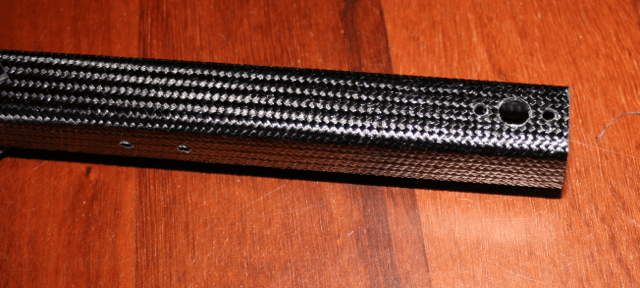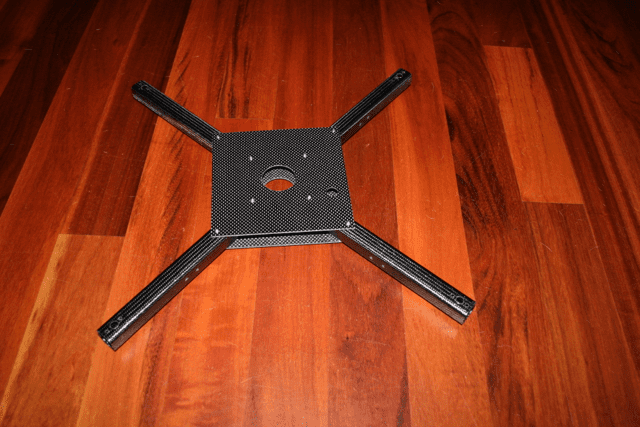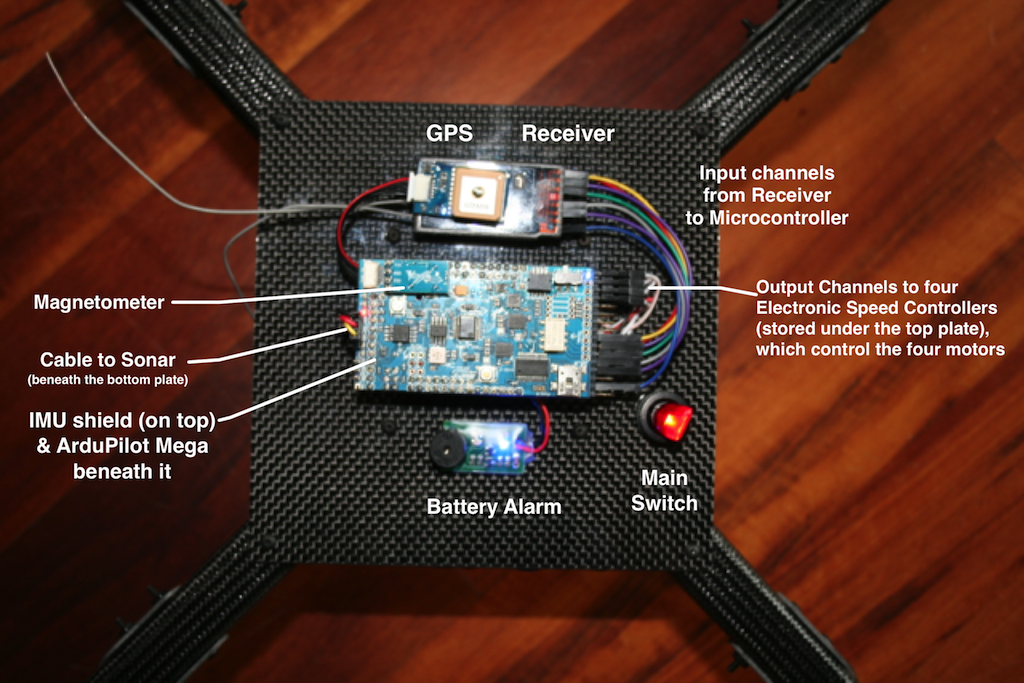Today, we would like to introduce Black Dragon, our newest flying robot quadrotor. This newest flyer incorporates everything we’ve learned to date about ease-of-use, modular maintainability, crash resistance, lightness, and safety. While we constructed all our previous full-sized quadrotors with aluminum, we designed and built this new flyer with super-cool carbon fiber material. This particular type of carbon fiber, which carries the brand-name “Dragon Plate” (www.dragonplate.com), is used in the aerospace and defense industry, among others. It’s very light, very strong, looks fantastic (the photos don’t do it justice), and is surprisingly machinable.

Carbon Fiber Arm. Note that we drilled the motor holes and landing gear holes directly into the arm in order to reduce parts
Like our previous quadrotors, we are using the Arduino-based ArduPilot Mega board as the main controller, a 3-axis Inertial Measurement Unit shield (IMU), a GPS for autopilot navigation, Magnetometer for heading control, and a Sonar for altitude control. The robot can be flown via an RC controller or on various autopilot modes. New features include a large illuminated toggle switch for easy on/off in the field, large main plates to hold electronics and wires, improved frame design, complete elimination of the motor mounts (which used to be susceptible to bending), an x-oriented frame (as opposed to +) to provide an open field of view for a camera mounted on the the front, and improved landing gear.
The carbon fiber material is excellent. We love it. It’s easier to machine and work with than we expected (even with the necessary safety precautions), it’s very attractive, but best of all it’s both very light and very strong. For example, the previous aluminum arms weighed in at about 50 grams each. The new arms are 21 grams each. The whole unit ways in at about 850 grams without the LIPO battery.
We’ve loaded the software into the microcontroller, calibrated the ESC/motors, double-checked the prop rotation, tested the sonar, set the magnetic declination on the magnetometer, confirmed the GPS is giving good long/lat, and it’s ready to fly. We’ve flown it a few inches off the floor indoors just to make sure it’s good-to-go and so far it seems excellent. Perhaps our best ever. As soon as the rain stops, we’ll be testing it in the big blue sky.
For more details on our various flying drone robots, go here.
I want to give special thanks to the folks at Dragon Plate for sending us their cool material.






He is so shiny! I love the way he glistens in different lights! I also love the new labels on the pics! FABB, U, LLOUS!!!!!!!!!
Wow, it looks amazing, interesting like a piece artwork. I hope it flies just as well on that sunny day.
what is the $$ on the “BLACK DRAGON” LOOKS LIKE A KIT IN THE MAKING..
It’s really cool, can you post a video of black dragon flying?
Thanks, Isabel. Yes, I definitely will. 🙂
Cool, I can’t wait to see it fly.
Neat work guys! I was excited to see some fellow robot builders in NC (I’m in Raleigh). Maybe we’ll get to meet some day.
What’s the payload?
it’s cool….
can you mail me the details of the your flying robot….
I could spend all their measure of black dragon?
I have also AUTO CAD program,
to send me the file.
i’m always lovnig great stretching advice most of my problems with running have occured in my feet..oddly enough. I’m pretty sure I have an issue with plantar fascitis in my right foot as long as I ice my foot with a frozen water bottle and massage my foot with a golf ball, it helps alot. i’ve never tried foam rolling before, but I really need to start I think injuries are prob what tend to scare runners the most i know thats how I feel anyways I think the best way to avoid it is just train smartly. Overtraining is so easy to do that its crazy I’ve struggled with it myself. Its all a learning experience right?I cant stand GUs, they make me gag. I’ve used the sport jelly belly beans and they are decent but my all time fave is Cliff shot blocks, they work really well for me and settle down nicely in my stomach. plus they are yummy Theresa recently posted..
Posted on Tell us stomehing we don’t knowEveryone loves to hear stomehing new, or to be told a story that no one knows. So when you speak to reporters (both written press and TV interviewers), try to let slip a snippet of original info either stomehing about yourself that most people do not know, an insight into your training, or a reflection of your feelings and emotions during the competition. As difficult as it might be to think of stomehing original to say after a race when the brain is starved of oxygen, a little imagination can go a long way.
Me again. What program do you use for cad? I personally use auto cad professinal (student)
hi!! its an awesome project!! looking at this innovative project i have made this my final year project for my engineering!! but sir can you help me the components needed and the design of the quadrotor..please send a mail regarding these to vinjohnvc@gmail.com so that i can start with my project.
thankyou sir.
Sir can you give me circuit diagram with specification
Dear Sir,
I have seen your amazing work and its so nice. I also want to make it for which i need the circuit diagram of this drone with its remote circuit diagram and i also want the list of material required.
Hope u will understand and make a step towards me.
Thanks.
My email: iamking123786123@gmail.com
please send me the circuit diagram of this drone with its remote controller circuit diagram as I wish to develop it here.
I would be very grate full if you help me.
Thanks in advance.